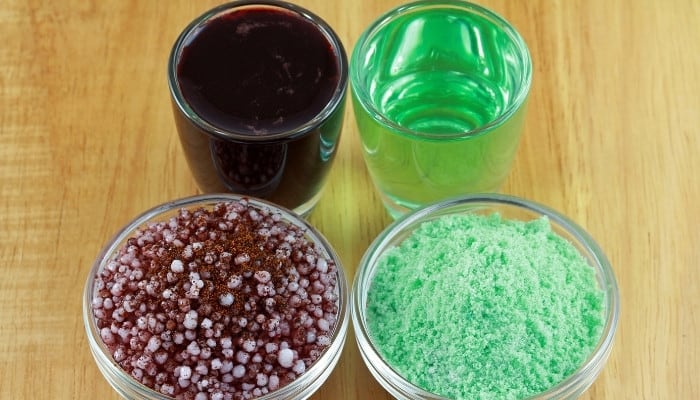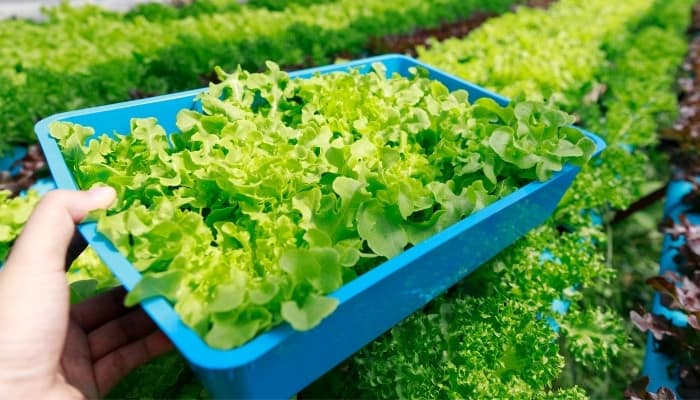If you are unfamiliar with hydroponics or revisiting your knowledge on the subject, you will likely come across the term TDS frequently.
But, with pH, EC, PPM, and other references to keep up with, remembering exactly what TDS even stands for is an easy piece of hydroponic information to forget.
What is TDS in hydroponics? Total Dissolved Solids, or TDS, in hydroponics is the measurement of how much salt, nutrients, and other concentrates are present in the water. The TDS is measured in parts per million, or PPM. Monitoring the TDS of hydroponic systems is crucial for successful operations.
Read on below to learn more about TDS levels and their importance in hydroponics.
TDS Levels in Hydroponics
As stated above, TDS levels in hydroponics refer to the amounts of concentrated salt and nutrients in the water.
Below, we discuss each of the most significant factors about how TDS levels relate to hydroponics.
Understanding TDS in Hydroponics
TDS levels are crucial to stay on top of and monitor closely in hydroponics.
Not only does having a proper TDS level in hydroponics help your plants thrive, but it also lessens the possibility of them suffering from too little or too many nutrients.
TDS levels also help you maintain a proper level of concentrated salt in your water, which also affects the overall ability of your plants to uptake enough water, air, and nutrients.
What’s a Good TDS Level for Hydroponics?
The “best” TDS level, generally speaking, is approximately 800. Most plants thrive within TDS levels of 600 to 1000, hence 800 is the sweet spot.
That said, it’s always wise to check the preferred TDS level for any crop you plan on growing. For example, bok-choy thrives best in a TDS level of over 1,200.
How Important is PPM in Hydroponics?
PPM is another crucial measurement to routinely monitor when growing hydroponically. The PPM measurement lets you know whether more nutrients are required yet or not.
Likewise, PPM lets you know if your water has nutrient levels that are too high.
The PPM measurement is extremely important because it more or less tells you when it’s time to feed your plants or if they are overfed.
Do You Need a TDS Meter for Hydroponics?
An accurate TDS meter (like the Health Metric TDS Meter) is absolutely necessary for growing hydroponic crops without guesswork.
Without a TDS meter, you are leaving the performance of your system and plants up to chance.
Are TDS Meters Accurate?
TDS meters today are extremely accurate. Even better, the best TDS meters are self-calibrating or come with an easy-calibration feature.
We recommend investing in a high-quality TDS meter. That way, you know you’re getting the most accurate information about your hydroponic water.
What TDS Meter Readings Mean in Hydroponics
The TDS level of hydroponic water can be read on a meter quickly and efficiently. Simply stick the probes in the water and wait.
The reading that shows on the meter gives you the amount of crucial concentrates (salt and nutrients) in the water.
How Often To Check TDS Levels
TDS levels should be checked as often as possible. At the very least, they should be checked on a daily basis.
Keeping a close eye on TDS levels helps you keep your plants in an optimal state to grow and flourish.
If checking the TDS level daily isn’t feasible for you, check them as often as possible. That way your plants won’t suffer from a lack of nutrients or water.
Ideal TDS Levels for Different Plants in Hydroponics
The ideal TDS reading for plants grown hydroponically varies from around 500 or 600 on up to well over 1,000. That said, we suggest sticking with a TDS level of around 800.
Leafy greens, like lettuce and spinach, for example, require a TDS level of around 550 to 850, much lower than the 1,200-plus that bok-choy needs.
The reason behind such drastic TDS levels is in the amount of energy and nutrients needed by the plants, how fast they use said supplements, and how much water they include in their makeup.
Ideal TDS Level for Commonly Grown Hydroponic Plants
TDS vs. Conductivity (EC)
TDS and EC are similar in that they both measure something that indicates how well your plants are currently able to uptake water and nutrients.
TDS lets you know how much nutrients are in the water.
EC allows you to measure the conductivity of the water, which lets you know how well the plants can absorb available nutrients.
How To Increase TDS Levels in Hydroponics

Increasing TDS levels in hydroponics is extremely simple.
After you’ve taken a reading, simply take your solution for TDS (probably a nutrient solution, though possibly a powder), and mix it into water.
Typically, you need only add a bit of solution to a liter/gallon of water. After the solution is mixed, introduce it into your system and take a new TDS reading. Adjust according to the reading.
If the measurement is still too low after adjusting, try mixing a bit more nutrient solution and add it into your reservoir.
Depending on your product, this could be as much as a few teaspoons to an entire liter of solution.
How To Lower TDS in Hydroponics
Lowering TDS levels in hydroponics is just as straightforward as increasing TDS levels are.
In fact, it is the same exact steps we just covered above, except for using a different solution. This solution is specifically for lowering TDS levels.
If salt or nutrients in your hydroponic water is still too high, dilute the water by adding clean fresh water into the system.
Keep testing until the TDS reading is where it needs to be. Likewise, if the reading is too low, you’ll need to add more nutrient solution.
Related Questions:
Do TDS Meters Measure Chlorine?
TDS meters do not measure chlorine; they strictly measure the salt and nutrient concentrations in the water.
That said, chlorine isn’t such a great idea in hydroponics, besides using it for cleaning the system from time to time.
Do TDS Meters Measure Calcium?
TDS meters are designed specifically for measuring the levels of salts and nutrients in the water.
TDS meters do not measure calcium, though some, depending on the model, will also measure EC and temperature.
Final Thoughts About Hydroponics TDS Level
If you’re starting a hydroponic garden anytime soon, you need to get your hands on a TDS meter as soon as possible.
Growing hydroponic plants without a TDS meter is not advisable as it just leaves too much up to guesswork.
Monitoring TDS levels on a regular basis helps you protect your plants from nutrient burn or starving for oxygen, water, and nutrients.
That means they help you keep your plants thriving in their Goldilocks zone.

